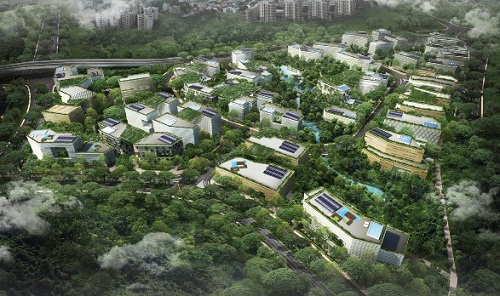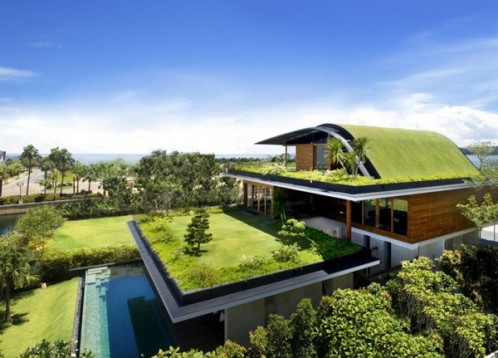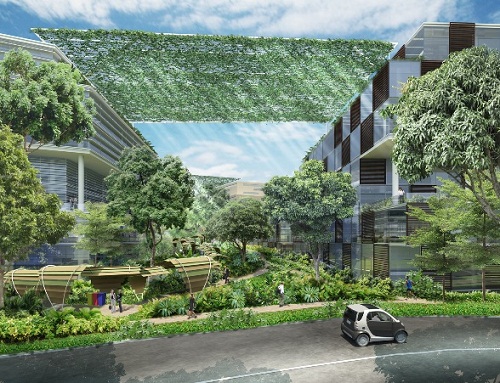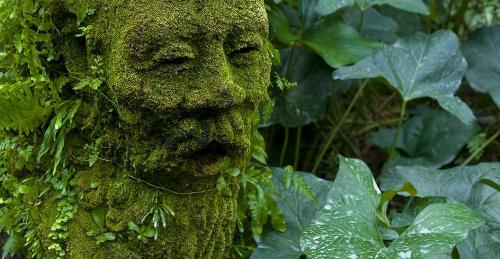Editor's Note: This photo essay is not meant to depict general living conditions for many of Asia's billions of people; nor is it meant to describe other cities in Asia or anywhere in the world. Rather, it is meant only to portray in our small way what can be done to support nature and improve the lives of people in a city of 5 million people when governments are willing to commit more resources to nature and human health and less to corporate profit, concrete and glass. - LMB
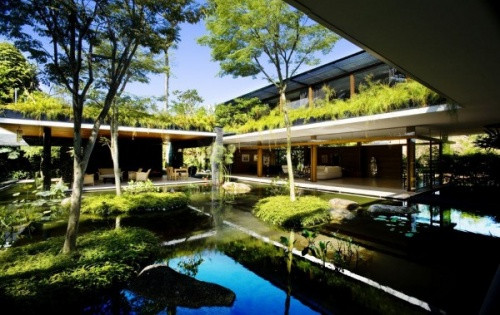
Green family homes in Singapore (Source: Inhabitat)
|
|
| JTC Corporation recently unveiled the masterplan for the CleanTech Park (CTP), Singapore’s first eco-business park for companies involved in clean technologies and sustainable urban solutions. The 50-hectare CTP will be developed next to the Nanyang Technological University so as to enhance the integration between the academia, research institutes and the business industry, and provide synergies for the full value chain of the clean tech industry. The development will take place in 3 phases over 20 years. Phase 1 will commence in July 2010 and will provide about 17 ha of business park land when completed in 2018. Phase 2 will be developed from 2019 to 2025, and Phase 3 from 2026 to 2030. The CTP will house a working population of 20,000 when it is fully built by 2030. The designated Green Corridors are green areas between the buildings and land parcels within CTP. These green corridors are strategically located to provide secondary greenery between the buildings and land parcels and are aimed at promoting enhanced walkability within the Park. (Source: Anders Bekenen) |
|
|
| "The Meera House, With A Garden on Every Floor." Everyone craves natural surroundings at some level and the wealthy are no exception. (Source: Green Muze) |
|
|
|
| Singapore's skyline is even turning green with skyscrapers like this one (Source: Inhabitat) |
|
|
| Singapore's sky trellis will be constructed between adjacent buildings and covered with plants. By shading open spaces between buildings, it can reduce heat gain by the buildings from the environment and enhance walkability within open spaces in the area. (Source: Anders Bekenen) |
|
|
| Green goes higher with futuristic buildings like "Fusionopolis," designed by architect Ken Yeang named . (Source: Fusionopolis) |
|
|
| If art school was in our future we might opt to study under, or on top of, the amazing green roof at the School of Art, Design and Media at Nanyang Technological University in Singapore. This 5 story facility sweeps a wooded corner of the campus with an organic, vegetated form that blends landscape and structure, nature and high-tech and symbolizes the creativity it houses. (Source: Inhabitat) |
|
|
| "Connecting Plants With People" is the motto of Singapore's Botanic Gardens. Wise old sages peer out from the foilage. (Source: SBG) |
|
|
| Green Tropical Family Residences in Singapore (Source: Best Home) |
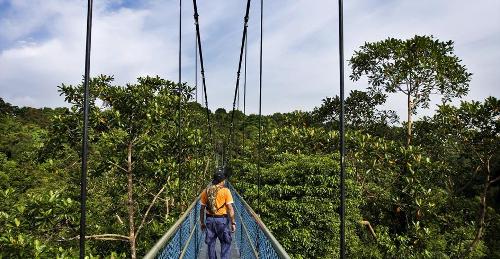
"In the heart of Singapore, are lush, rainforest trails, lakeside boardwalks, and the expansive parkland of the MacRitchie Reservoir." Jan Jekielek reports on the the 2,000 hectare (4,923 acres) Central Catchment Nature Reserve, first established in 1868 to save the important watershed region from the wholesale clearing that had occurred on the island. "The location and construction method for the 25 m high Tree Top Walk at MacRitchie Reservoir were specially selected to avoid disturbing local plant and animal life. Thus, the free-standing suspension bridge’s has a capacity of 30 people which is strictly enforced through a system of one-way traffic." -Jan Jekielek, The Epoch Times)
Photo essay by Axis of Logic
Singapore aims to become a city
by David Roberts
GRIST, August 11, 2011
I really, really dig what Singapore is trying to do. Currently it's about half covered in green and wants to go farther:
In Singapore's next "green road map," its 10-year development plan, the country aims to go from being "a garden city" to "a city in a garden." "The difference might sound very small," says Poon Hong Yuen, the chief executive of the country's National Parks Board, "but it's a bit like saying my house has a garden and my house is in the middle of a garden. What it means is having pervasive greenery, as well as biodiversity, including wildlife, all around you." ...
"As we've moved into the more knowledge-based industries, they bring along talent who like to live in a great city," said Mr. Poon. "It's no longer about being well tended, but also about the livability, the excitement of living in a great city -- and biodiversity is part of it."
There's reason to believe that exposure to trees, parks, and forests benefits physical and psychological health. I expect the same is true of exposure to bees, butterflies, birds, and other creatures who might be persuaded to cohabit with humans in green cities. Of course greenery also cleans the air and enriches the soil, reducing runoff pollution. Yay for urban nature!
In particular, increasing greenery and biodiversity in cities would serve the important project of making cities friendlier places to raise children. I had a long, eye-opening discussion with author Richard Louv a few years ago about this. He wrote a book called Last Child in the Woods: Saving Our Children from Nature-Deficit Disorder about the immense body of research showing how much children are harmed by being deprived of natural settings.
Finally, pushing up the level of biodiversity in a city would represent an important test case. There's all sorts of fascinating research going on right now about urban ecosystems, with sometimes surprising findings about the interaction of flora, fauna, water use, and air quality. I certainly suspect that increasing biodiversity in the city will produce all kinds of welcome results, but it would be nice to have empirical evidence in hand.
Anyway, woo Singapore.
